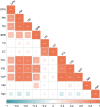Associations between seminal plasma osteopontin level and sperm motility in infertile men with asthenozoospermia
- PMID: 40458181
- PMCID: PMC12127178
- DOI: 10.3389/fendo.2025.1487650
Associations between seminal plasma osteopontin level and sperm motility in infertile men with asthenozoospermia
Abstract
Purpose: Male infertility, a complex multifactorial condition, is frequently caused by asthenozoospermia (AZS). Although osteopontin (OPN) has been implicated in mammalian reproduction, its specific effects on sperm motility and fertility are not well understood. This study investigates the relationships between seminal plasma OPN levels and sperm parameters in cases of male infertility.
Methods: A total of 158 semen samples were analyzed, comprising 78 from infertile men with AZS and 80 from healthy fertile controls. OPN concentrations in seminal plasma were measured using the ELISA method. Additionally, we assessed the in vitro effect of OPN on sperm motility parameters in AZS patients and controls.
Results: Significantly lower OPN concentrations were observed in the seminal plasma of infertile men with AZS compared to healthy controls (P<0.0001). OPN levels discriminated between the groups, with an area under the curve of 0.793. Additionally, in vitro OPN treatment significantly improved sperm motility in the AZS group, enhancing progressive and total motility, as well as kinematic parameters in a concentration-dependent manner.
Conclusions: This study established a link between OPN level and sperm motility in infertile individuals with AZS, suggesting the potential of OPN as a biomarker for AZS and as a supplement for assisted reproductive techniques.
Keywords: asthenozoospermia; male infertility; osteopontin; seminal plasma; sperm motility.
Copyright © 2025 Zhang, Leng, Liu, Liu, Li and Qin.
Conflict of interest statement
The authors declare that the research was conducted in the absence of any commercial or financial relationships that could be construed as a potential conflict of interest.
Figures






Similar articles
-
Efficacy of In Vitro Addition of Low-Dose Arachidonic Acid in Improving the Sperm Motility of Obese Infertile Men With Asthenozoospermia.J Biochem Mol Toxicol. 2025 Mar;39(3):e70165. doi: 10.1002/jbt.70165. J Biochem Mol Toxicol. 2025. PMID: 39987515
-
Low-molecular weight compounds in human seminal plasma as potential biomarkers of male infertility.Hum Reprod. 2018 Oct 1;33(10):1817-1828. doi: 10.1093/humrep/dey279. Hum Reprod. 2018. PMID: 30239786
-
Exploring correlations: Human seminal plasma and blood serum biochemistry in relation to semen quality.PLoS One. 2024 Jun 24;19(6):e0305861. doi: 10.1371/journal.pone.0305861. eCollection 2024. PLoS One. 2024. PMID: 38913627 Free PMC article.
-
Genetic underpinnings of asthenozoospermia.Best Pract Res Clin Endocrinol Metab. 2020 Dec;34(6):101472. doi: 10.1016/j.beem.2020.101472. Epub 2020 Nov 6. Best Pract Res Clin Endocrinol Metab. 2020. PMID: 33191078 Review.
-
Exploring the Role of Oxidative Stress in Sperm Motility: A Proteomic Network Approach.Antioxid Redox Signal. 2022 Sep;37(7-9):501-520. doi: 10.1089/ars.2021.0241. Epub 2021 Dec 24. Antioxid Redox Signal. 2022. PMID: 34847748 Review.
References
MeSH terms
Substances
LinkOut - more resources
Full Text Sources
Medical
Research Materials

